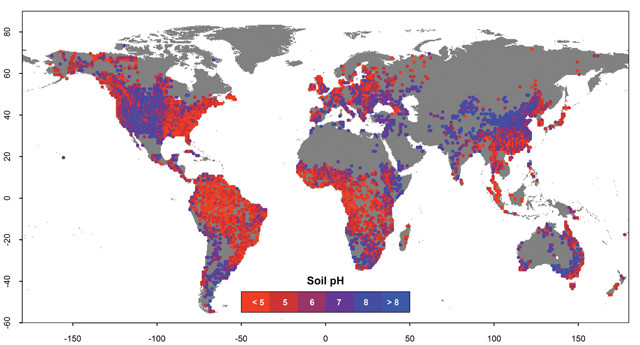
by Lucas Joel Wednesday, March 29, 2017

This global soil acidity map shows acidic areas in red and alkaline areas in blue. Credit: University of California, Santa Barbara.
The acidity of soils, which affects soil fertility, depends largely on a region’s climate. What has been less clear is just how abrupt — or gradual — shifts in acidity are at the boundaries between adjacent regions with different climates. In a new study in Nature, scientists report that acidity transitions are indeed abrupt, and the results may provide a glimpse into how plant communities will evolve as the planet’s climate continues to change.
“We found that if you go to wet climates — places where you might expect to find a forest, whether in the high latitudes or in the Amazon — the pH is acidic,” said Eric Slessarev, a doctoral student at the University of California, Santa Barbara, and lead author of the new study, in a statement. “If you go to dry climates, the pH is alkaline. This is what we expected. But our analysis was able to confirm that the transition between these two zones is very abrupt.”
To spot soil acidity transitions, the team analyzed soil databases from Australia, Brazil, Canada, China and the United States, as well as from the International Soil Reference and Information Center in the Netherlands. They found that many agricultural regions “sit on the edge between wet and dry climates,” Slessarev said. This means that “a very small change in climate could make a big difference in how the system functions.” If a particular region receives more or less precipitation in the future, the acidity of soil in the region will change, thus causing shifts in the kinds of plants that can, or cannot, grow there.
© 2008-2021. All rights reserved. Any copying, redistribution or retransmission of any of the contents of this service without the expressed written permission of the American Geosciences Institute is expressly prohibited. Click here for all copyright requests.